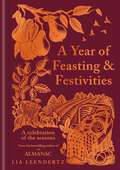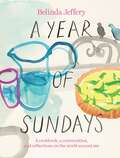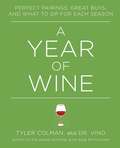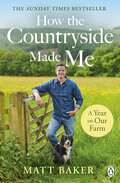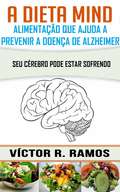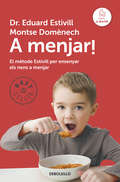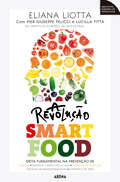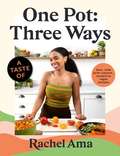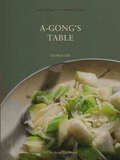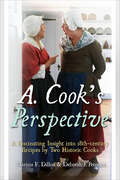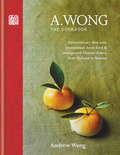- Table View
- List View
A Year in 120 Recipes
by Jack MonroeCook locally and seasonally with 120 affordable, simple and delicious recipes from the bestselling and award-winning food writer and anti-poverty campaigner behind Tin Can Cook and A Girl Called Jack.'Every now and again a food writer with a fresh and authentic voice comes along, and Jack Monroe is that rare find' NIGELLA LAWSONA Year in 120 Recipes is a mouth-watering seasonal guide through how to make the most of the food around you.By dividing the year into six sections, Jack Monroe teaches us how to make the most of seasonal produce, with affordable and tasty recipes to please everyone.Recipes include:· Radish, Pea and Mint Risotto· Smoked Mackerel with Rhubarb Salsa· Lamb and Aubergine 'Baba Gosht' Curry· Brown Sugar Meringues with Blackberry YoghurtUsing accessible ingredients and easy-to-follow guidance, Jack's recipes are bursting with taste and goodness while always keeping to a tight budget.Let A Year in 120 Recipes help you discover simple cooking and delicious eating all year round.Praise for Jack Monroe:'Jack's recipes have come like a breath of fresh air in the cookery world' NIGEL SLATER'A terrific resource for anyone trying to cook nutritious and tasty food on a tight budget' Sunday Times'A plain-speaking, practical austerity cooking guide - healthy, tasty and varied' Guardian'A powerful new voice in British food' Observer'Packed with inexpensive, delicious ideas to feed a family for less' Woman and Home
A Year of Beautiful Eating: Eat fresh. Eat seasonal. Glow with health, all year round.
by Madeleine ShawIn A Year Of Beautiful Eating, bestselling nutritional health coach Madeleine Shaw shows you how to eat your way to health and beauty all year round. With over 100 nutritious and wholesome recipes packed with flavour and medicinal benefits, Madeleine focuses on the importance of eating in tune with nature and supercharging your plate with what your body needs to look and feel beautiful season by season.Toast the longer days of spring with Lamb Chops with Parsnip Mash and Asparagus; cool off with a Papaya and Peanut Salad in summer; embrace the autumn with a Pumpkin and Red Cabbage Salad with Miso Dressing and indulge in winter with Coconut Chocolate Chunk Cookies. No matter your mood, this is good, wholesome eating, every day of the year.
A Year of Beautiful Eating: Eat fresh. Eat seasonal. Glow with health, all year round.
by Madeleine ShawIn A Year Of Beautiful Eating, bestselling nutritional health coach Madeleine Shaw shows you how to eat your way to health and beauty all year round. With over 100 nutritious and wholesome recipes packed with flavour and medicinal benefits, Madeleine focuses on the importance of eating in tune with nature and supercharging your plate with what your body needs to look and feel beautiful season by season.Toast the longer days of spring with Lamb Chops with Parsnip Mash and Asparagus; cool off with a Papaya and Peanut Salad in summer; embrace the autumn with a Pumpkin and Red Cabbage Salad with Miso Dressing and indulge in winter with Coconut Chocolate Chunk Cookies. No matter your mood, this is good, wholesome eating, every day of the year.
A Year of Feasting & Festivities: A Celebration of the Seasons
by Lia LeendertzA Year of Festivities & Feasting is a delightful collection that celebrates the bounty of nature, the joy of seasonal cooking, and the stories that connect delicious foods with some of our most sacred annual traditions.People find joy in the rhythms of nature. We delight in the taste of fresh ingredients, the turning of the seasons and the earth below our feet, and the joy of gardening. The seasons, with their ever-changing abundance, offer us endless opportunities to savour nature's gifts, from wild garlic in springtime to juicy berries in summer, autumn mushrooms, and winter root vegetables. This beautiful collection features a wide variety of recipes to celebrate special moments throughout the year and reveals the story of why we associate such events with certain foods, from the traditional Burn's Night meal of Cullen Sink to Cornish Saffron Buns, Midsummer Cushion Cakes to mark the Summer solstice, and Pot-roast Pheasant, Martinmas Beef and Feast of the Seven Fishes Pie as the colder months set in.This beautifully designed book will be a volume readers will treasure both this year and in those to come, and the perfect companion to A Year in Story and Song.
A Year of Feasting & Festivities: A Celebration of the Seasons
by Lia LeendertzA Year of Festivities & Feasting is a delightful collection that celebrates the bounty of nature, the joy of seasonal cooking, and the stories that connect delicious foods with some of our most sacred annual traditions.People find joy in the rhythms of nature. We delight in the taste of fresh ingredients, the turning of the seasons and the earth below our feet, and the joy of gardening. The seasons, with their ever-changing abundance, offer us endless opportunities to savour nature's gifts, from wild garlic in springtime to juicy berries in summer, autumn mushrooms, and winter root vegetables. This beautiful collection features a wide variety of recipes to celebrate special moments throughout the year and reveals the story of why we associate such events with certain foods, from the traditional Burn's Night meal of Cullen Sink to Cornish Saffron Buns, Midsummer Cushion Cakes to mark the Summer solstice, and Pot-roast Pheasant, Martinmas Beef and Feast of the Seven Fishes Pie as the colder months set in.This beautifully designed book will be a volume readers will treasure both this year and in those to come, and the perfect companion to A Year in Story and Song.
A Year of Living Consciously: 365 Daily Inspirations for Creating a Life of Passion and Purpose
by Gay HendricksEmbrace Each DayWe all want to live authentic, self-aware, and successful lives. How do we go about it? Where do we begin? In a daily map full of wisdom, inspirational quotes, and transformational exercises, bestselling author and psychotherapist Gay Hendricks sets us on a fantastic journey to personal and relationship success. In bite-size portions, Hendricks encourages understanding, self-awareness, and honesty-all vital elements in a conscious life. A Year of Living Consciously teaches us to relish the journey that results in greater self-esteem and emotional literacy, achievements that can only come from leading an examined life. Quotes from historical and literary figures reinforce the timeless importance of honesty and self-knowledge. By helping us see, comprehend, and ultimately embrace the secrets we often hide from ourselves. A Year of Living Consciously brings us into accord to create clearer understanding, genuine change, and self-realization.
A Year of Sundays: A cookbook, a conversation, and reflections on the world around me
by Belinda JefferyJoin Belinda Jeffery for A Year of Sundays as she shares the recipes, musings and memories that inspire her cooking. A collection of Belinda&’s much-adored and anticipated Sunday morning Instagram posts accompanied by beautiful recipes, A Year of Sundays is as much a conversation with a friend as it is a cookbook. Follow Belinda&’s gentle guidance through recipes gathered from her cooking school on the Far North Coast of New South Wales, to those crafted from the harvests of local producers and her own garden, and others embellished with the imprint of personal memories. Cooking from the heart to relish in the beauty of just-picked produce or to simply indulge a craving, Belinda imparts her recipes with both encouragement and genuine joy. From her reassuring instruction in the art of pastry and baking to her relaxed approach to everyday dishes made from the freshest ingredients, A Year of Sundays is a cookbook for all occasions, all kitchens and all cooks.
A Year of Wine
by Tyler ColmanA lively and informative guide to a year of wine enjoyment and appreciation from acclaimed wine expert and blogger Tyler Colman, aka "Dr. Vino" In A Year of Wine, award-winning educator Tyler "Dr. Vino" Colman, whose wine blog was hailed by Food & Wine magazine as "one of the seven best," views winter, spring, summer, and fall through the glass of his favorite impact-resistant stemware, pairing each month with its perfect ports, Pinots, and bubblies -- and offering good value recommendations for them all. Throughout, Colman reminds readers to try to pair their pours with context, which is wildly underrated when it comes to enjoying your favorite bottle. And while people tend naturally to drink lighter, more refreshing wines during the warm months and heavier, more serious wines during the winter months, Colman takes the seasonal approach a step further by offering innovative recommendations and enlightening facts that will allow readers to impress their friends for twelve months straight. Is there a perfect wine to serve with chips and salsa on Super Bowl Sunday? Which bottles will help you drown away your tax- day blues without blowing your new budget? Colman answers these questions and much more as he pairs wines with each season, occasion, and moment. Recommending thoughtful and affordable wines for special celebrations and everyday enjoyment, offering tips on beginning a wine collection or spring cleaning the one you have, exploring how to drink with the smallest possible carbon footprint, and explaining how to maximize your wine experience when you dine out, Colman makes wine easy to understand and, most important, to savor. Colman also shares the secret gems of his favorite wine tourism destinations -- where to find the best wine shops in Paris, which Portuguese vintners still crush grapes with their bare feet, and how you can take a ten-tasting-room tour with one stop in a tiny Oregon town -- and turns to some of the country's top sommeliers for their take on wine appreciation as well. Perfect for both seasoned wine enthusiasts and oenophobes, A Year of Wine is an innovative approach that will encourage readers to drink outside the bottle.
A Year on Our Farm: How the Countryside Made Me
by Matt BakerEscape into nature with Matt Baker's fascinating journey through the natural year and family life on the farm'A delight' Countryfile Magazine_______Matt Baker finds his calm on the farm.Surrounded by nature with his family, dogs, array of sheep, Mediterranean miniature donkeys and a whole host of wildlife in the farm's ancient woodland, Matt shows us how the power and beauty of the countryside can bring joy to us all.Following the ever-changing seasons of the year, we see woodland animals emerge after a long winter of hibernation and lambs begin to gambol in April. We hear the dawn chorus in the height of summer and see the preparations unfold for the harsh and wild winter months.Peppered with hand drawn sketches, unforgettable moments from Matt's TV career and stories of a landscape you'll fall in love with - from its sun-soaked pastures to 6ft snow drifts - Matt reveals how the outdoors has made him who he is today.
A cena con la dieta Wheat Belly
by Sarah Sophia Giancarlo AvellinoA cena con la dieta Wheat Belly Principi essenziali, volume 41 È giunta l'ora di abbandonare la stanchezza e l'apatia a favore di uno stile di vita più sano e più positivo. La longevità, come il benessere generale, è stata associata all'adozione di un sano regime alimentare. L'ultimo pasto del giorno deve prevedere alimenti che diano carburante all'organismo, agevolino il sistema digestivo e soddisfino la fame. Prendere la giusta direzione può fare la differenza nelle tue prestazioni al lavoro o a casa. Impara a goderti la vita un po' di più, aumenta la sicurezza in te stesso e adotta uno stile volto al benessere semplicemente modificando cosa assumi quotidianamente. Decidi subito di voler fare la differenza. Se rientri nella categoria dei milioni di persone con una vita frenetica e che ogni giorno consumano al volo pasti ricchi di grano, non devi sentirti solo. Esistono ottime diete e la Wheat Belly è tra le migliori. Sei stufo di sentirti gonfio, rallentato nei movimenti e con lo stomaco in subbuglio? Forse hai solo bisogno di adottare una dieta alimentare appagante e ricca di energia. Prova con il sistema Wheat Belly. Adottare uno stile di vita positivo potrà senz'altro darti cambiamenti notevoli, e non esiste momento migliore di adesso per iniziare con una modifica fondamentale - la tua cena. Il libro di ricette di cene Wheat Belly è un vero must per chi desidera ottenere maggiore energia, perdita di peso e un aspetto positivo. Impara ciò che migliaia di persone già sanno benissimo: eliminando determinati ingredienti, come il grano, dal regime alimentare quotidiano rallenterai l'accumulo di grasso, stimolerai le funzioni cerebrali e otterrai grandi soddisfazioni. Non esiste modo migliore per fornire carburante all'organismo che pasteggiare con una delle ricette consigliate in questo libro. Fai spazio ad abitudini sane. Inizia a trattare i
A dieta Mind, alimentação que ajuda a prevenir a doença de Alzheimer. Seu cérebro pode estar sofrendo
by Laís Alves Victor R. RamosMuito provavelmente seu cérebro está sofrendo neste instante, e você não tem maneira de saber ou de dizer, a não ser que seja demasiadamente tarde, quando começas a notar os sintomas de Alzheimer e os danos são irreversíveis. O cérebro humano evoluiu para buscar alimentos ricos em gordura e açúcar. Mas, uma preferência que começou como um mecanismo de sobrevivência, em nossos tempos, onde há abundância de tudo isto, se transformou numa compulsão autodestrutiva. A alimentação atual está nos conduzindo a todo tipo de problemas de saúde: obesidade, câncer, diabetes e doenças cardiovasculares, havendo uma crescente evidência que também desencadeia o Alzheimer, atualmente vista por alguns investigadores como outra forma de diabetes. Isto tem graves implicações: o mundo já enfrenta uma epidemia de diabetes e a perspectiva com uma epidemia paralela de Alzheimer, é em termos de sofrimento humano, e custo monetário, terrivelmente aterradora. A situação nutricional está se tornando cada vez mais difícil de controlar, já que poucas pessoas ouvem quando se diz que comidas são ricas em gordura e açúcar é um perigo para a saúde, e além do mais, as vendas de fast food seguem aumentando. O que se pode fazer? As campanhas de conscientização ao público para levá-los a uma dieta saudável e reverter a maré da obesidade tem conquistado um êxito limitado. Muitas pessoas tratam de fazer algo para corrigir essa situação, seguindo a dieta da moda, mas a maioria os faz por motivos estéticos, ou porque já tem problemas de saúde. E, o que podemos dizer do cérebro? Abandonado a sua sorte, a mercê de nossos maus hábitos de alimentação, dos conservados que tem nos alimentos processados, no excesso de açúcares e gorduras que consumimos, dos contaminadores do meio-ambiente e tudo isso ocorre porque nosso cérebro não se queixa, não re
A dieta para o câncer de cólon
by Gisele Zuvanov Dr Christopher Maloney N. D.Você ou um ente querido tem o diagnóstico de câncer de cólon? Você sabia que mudar a sua alimentação, diminuiu o risco de morrer mesmo depois de ter sido diagnosticado? Quando você terminar de ler este livro, quero que seja capaz de me dizer em um minuto ou menos, o como deve comer, como se exercitar e como tomar suplementos para diminuir sua chance de morrer de câncer de cólon depois de diagnosticado. Se puder fazer isso, por favor o faça por escrito nos comentários do livro e na minha página da internet para que eu e todo mundo leia. Quando eu recebi o diagnóstico de câncer de cólon, pesquisei o que poderia fazer e não encontrei as respostas que queria. Encontrei as melhores respostas disponíveis na literatura médica. O fato de ser um médico naturopata me ajudou nisso. Eu tenho muito conhecimento sobre os tratamentos convencionais e os alternativos. Além disso consigo ler em "medicalês" e passar para o leitor em uma linguagem mais clara. É terrível ter que encarar nossa situação atual, mas temos opções e este livro é a minha maneira de te dar direção e esperença.
A dieta purificadora
by Frank Laporte-AdamskiPurificar o intestino sem sacrifícios. O princípio-base da Dieta Purificadora é muito simples: quem comer bem terá uma boa digestão. E uma boa digestão é o segredo para uma vida melhor. <p> <p>«Os nutricionistas classificam os alimentos de acordo com a sua composição nutricional. Eu divido-os segundo a velocidade dos mesmos no trato intestinal. Os alimentos devem passar pelo tubo digestivo antes de serem absorvidos. Diferentes estudos demostraram que o intestino é o nosso segundo cérebro, onde se encontram as defesas imunológicas. É, por isso, muito importante não obstruir os órgãos digestivos: nos últimos trinta anos, estes são os princípios fundamentais que serviram de base ao meu método.» Tudo o que comemos deixa resíduos nas paredes do tubo digestivo, o que acaba por o irritar ou, no pior dos casos, por o entupir. O corpo sente-se pesado, menos activo e mais exposto a distúrbios como, por exemplo, dores nas costas, enxaquecas, insónias e problemas circulatórios. Durante mais de trinta anos, o naturopata e osteopata Frank Laporte-Adamski promoveu um método destinado a tratar melhor o «segundo cérebro» que temos na barriga e do qual dependem não apenas a digestão mas também 70% das funções do nosso sistema imunológico. Qual é o princípio subjacente da Dieta Purificadora? <p><p>Comer separadamente os alimentos de digestão rápida (30 minutos) e os desacelerados ou de digestão lenta (4-5 horas). É essencial evitar a combinação de alimentos rápidos e lentos: se estes se misturam, os tempos de digestão aumentam em grande escala, o sistema digestivo não pode eliminar completamente os resíduos e a acumulação de toxinas prejudica outros órgãos. Para além desta divisão dos alimentos, Adamski sugere o exercício físico, que estimula o diafragma, massaja a barriga e é essencial para reactivar a circulação sanguínea e reduzir o inchaço abdominal.
A menjar!
by Eduard Estivill Montse Domènech«Ja ho he provat tot i no hi ha manera que mengi.» Per molts pares, lhora de menjar dels nens es converteix en un infern. La boca tancada -que no sobre ni quan traiem totes les joguines, encenem la televisió o disfressem els plats amb la seva salsa preferida- és el nostre pitjor malson. Vist lèxit del seu mètode per resoldre els problemes de linsomni infantil, el doctor Eduard Estivill es va preguntar si hi hauria també un mètode que pogués aplicar-se al problema de lalimentació infantil. Per això va sol·licitar lajuda duna pedagoga, Montse Domènech, i entre els dos varen desenvolupar un mètode senzill, pràctic, amb unes sòlides bases científiques, per ensenyar a menjar bé, i de tot, als nens. Després dhaver-lo posat en pràctica durant tres anys, amb èxit en més del noranta-vuit per cent dels casos, shan decidit a publicar aquest manual tan amè que ajudarà els pares a ensenyar els seus fills a menjar.
A pranzo con la dieta Wheat Belly
by Sarah Sophia Giancarlo AvellinoA pranzo con la dieta Wheat Belly Principi essenziali, volume 42 È giunta l'ora di abbandonare la stanchezza e l'apatia a favore di uno stile di vita più sano e più positivo. La longevità, come il benessere generale, è stata associata all'adozione di un sano regime alimentare. Il pranzo di ogni giorno deve prevedere alimenti che diano carburante all'organismo, stimolino gli enzimi della digestione e soddisfino la fame. Prendere la giusta direzione può fare la differenza nelle tue prestazioni al lavoro o a casa. Impara a goderti la vita un po' di più, aumenta la sicurezza in te stesso e adotta uno stile volto al benessere semplicemente modificando cosa assumi quotidianamente. Decidi subito di voler fare la differenza. Se rientri nella categoria dei milioni di persone con una vita frenetica e che ogni giorno consumano al volo pasti ricchi di grano, non devi sentirti solo. Esistono ottime diete e la Wheat Belly è tra le migliori. Sei stufo di sentirti gonfio, rallentato nei movimenti e con lo stomaco in subbuglio? Forse hai solo bisogno di adottare una dieta alimentare appagante e ricca di energia. Prova con il sistema Wheat Belly. Adottare uno stile di vita positivo potrà senz'altro darti cambiamenti notevoli, e non esiste momento migliore di adesso per iniziare con una modifica fondamentale - il tuo pranzo. Il libro di ricette di pranzi Wheat Belly è un vero must per chi desidera ottenere maggiore energia, perdita di peso e un aspetto positivo. Impara ciò che migliaia di persone già sanno benissimo: eliminando determinati ingredienti, come il grano, dal regime alimentare quotidiano rallenterai l'accumulo di grasso, stimolerai le funzioni cerebrali e otterrai grandi soddisfazioni. Non esiste modo migliore per fornire carburante all'organismo che pasteggiare con una delle ricette consigliate in questo libro. Fai spazio ad abitudini sane. Inizi
A revolução smartfood
by Eliana LiottaDieta fundamental na prevenção deCancro - Doenças cardiovasculares - Doenças metabólicasDoenças neurodegenerativas - Controlo de peso Este guia explica de forma clara e simples quais os alimentos, que quantidades e como deve ingeri-los para viver mais e melhor. Smartfood é:A primeira dieta europeia com um marco científico, o do célebre Instituto Europeu de Oncologia;Uma dieta para prolongar a vida, com 30 superalimentos que regulam o metabolismo e previnem o cancro e outras patologias;Uma dieta para perder peso, fácil de seguir e que não impõe grandes sacrifícios. O programa Smartfood, criado em colaboração com o reputado Instituto Europeu de Oncologia (IEO) de Milão, baseia-se em milhares de pesquisas e estudos avançados da nutrigenómica, a disciplina que identifica a relação entre o património genético e os alimentos. Sabe-se hoje que certos alimentos têm poder curativo e são capazes de cuidar e proteger o corpo. São eles os protagonistas do programa Smartfood; 30 superalimentos que não podem faltar na sua mesa, pois constituem os aliados perfeitos da saúde e da linha. São alimentos «smart» - brilhantes ou inteligentes -, porque a sua acção sobre o nosso corpo é extraordinária. Saciam, evitam a acumulação de gordura, previnem as doenças e prolongam a vida. Trata-se de alimentos comuns como a alface, os cereais integrais, os morangos ou os pistácios. Neste livro, Eliana Liotta explica de forma simples como introduzir estes alimentos na nossa dieta e revolucionar, com poucas mudanças, o nosso estilo de vida. Fácil de seguir, a dieta Smartfood propõe um método em duas etapas para abraçar uma alimentação mais saudável, sem sacrificar os hábitos alimentares. Os resultados? Para além de fazer perder os quilos a mais, esta dieta é fundamental na prevenção do cancro, doenças cardiovasculares, metabólicas e neurodegenerativas. Sobre A revolução smartfood:«A regra fundamental é não acreditar em milagres e perdas de peso drásticas, porque, depois de os eliminarmos, os quilos recuperam-se rapidamente e podem trazer com eles doenças e distúrbios. Esqueça os magos e gurus da moda e confie na ciência. Como no caso de A Revolução Smartfood, que recebe a 'bênção' do IEO, o Instituto Europeu de Oncologia.»Il Messaggero
A roda da felicidade
by Susete EstrelaAprenda a Nutrir-se Emocionalmente! Descubra como ser dono da sua saúde e dê um novo significado à sua vida! Com A Roda da Felicidade, Susete Estrela leva ao mundo a mensagem de que parte da solução para uma alimentação saudável pode estar fora do prato. Preparado para ir em busca do "seu saudável"? PORQUE ignoramos a nossa biografia quando queremos curar a nossa biologia? COMO podem eventos tristes da infância influenciar o nosso peso? QUANTO de si é peso emocional? QUEM das suas relações mais prejudica a sua saúde? QUAL a dieta emocional e nutricional que melhor serve a sua felicidade? A autora criou o conceito de "banquete da vida", no qual os alimentos podem ser servidos tanto num "prato emocional" como num "prato nutricional". Sempre que o primeiro está mais vazio, vingamo-nos no segundo. Com dicas valiosas e perguntas pertinentes desde a primeira página, este é o livro que o ajudará a introduzir mais alegria e satisfação na sua vida, mostrando que os eventos do passado, a nossa história, a nossa biografia influenciam em muito as escolhas alimentares do presente. Descubra ainda as dietas mais antigas e populares do mundo e como as pessoas mais longevas, felizes e saudáveis nunca se preocuparam com as dietas da moda nem com o "último" estudo científico. Atreva-se a ser feliz! E levante-se da mesa sempre que o amor deixar de ser servido.
A sembrar sopa de verduras (¡Arriba la Lectura!, Big Book Unit 3 #8)
by Lois EhlertNIMAC-sourced textbook
A taste of One Pot: Three Ways
by Rachel AmaTHREE DELICIOUS VEGAN RECIPES FOR FREE!GET A TASTER OF ONE POT: THREE WAYS BY RACHEL AMA NOW.Rachel Ama is reframing vegan cooking. Create a veg-packed centrepiece dish in one pan/pot/tray and choose from three creative and flavoursome ways to either serve it up with just a few ingredients or transform it into something else entirely.This sampler will give you a taste of how Rachel takes one hero recipe and create three other dishes with it to put flavour and flexibility at the heart of your kitchen.The options are endless - level up your leftovers and create a new feast each day, scale portions up or down, cook all three serving options for a vegan feast with friends, or freeze leftovers to refresh later when you're strapped for time - whatever you choose, this way of cooking will help you have dinner part-ready-and-waiting, making plant-based eating feel even more achievable every day.In this sampler, find out how you can serve up or refresh Rachel's delicious Caribbean Curried Jack into: 1. Coconut Rice & Coleslaw 2. Coconut Flatbreads with Tomato & Red Onion Salad 3. Caribbean Patties with Orange & Avocado SaladOnce you've worked your way through these brilliant recipes, be sure to order the whole book to unlock the rest of the recipes that will transform your cooking.
A taste of... Bake Me I'm Yours… Cupcake Fun
by Carolyn WhiteFive baking projects from Carolyn White's Bake Me I'm Yours . . . Cupcake Fun. Be inspired by these fun collections of cupcakes, with designs including playful puppy faces, mooing cows, aliens, pop idol singers and their microphones, and wicked pirates and their buried treasure!
A-Gong's Table: Vegan Recipes from a Taiwanese Home (A Chez Jorge Cookbook)
by George LeeA rendering of food through the memories of family and of home: over ninety plant-based recipes from George Lee, the creator of Chez Jorge, with Laurent Hsia's images of Taiwan.&“An astonishingly accomplished exploration of flavors, ingredients, and traditions.&”—Katy Hui-wen Hung (洪惠文), co-author of A Culinary History of Taipei: Beyond Pork and Ponlai &“This is a beautiful love letter to Taiwan and a quietly uncompromising work of documentation.&”—Hannah Che, author of The Vegan Chinese KitchenGeorge Lee grew up with his A-Gong (grandfather) in the quiet refuge of Tamsui, Taiwan. He took part in the myriad Taiwanese food traditions his A-Gong nurtured, until he was seventeen, when his A-Gong passed. In observation of the death, he and his family undertook a set of Buddhist funeral customs and abstained from eating meat. For a hundred days, they ate at the monastery and the nuns there taught him to cook. Years later, he revisited the lessons and pieced them into the story of his family&’s cooking. Some recipes he shares here are directly from childhood: Han-tsî-bê, an everyday breakfast congee floating with fist-size chunks of golden sweet potatoes, and the quintessential preserve Tshài-póo, crunchy strips of sun-dried daikon radish that salt in the air for a few days in January. Others tread the boundaries between old and new, such as Sòo-lóo-pn̄g, a meatless rendition of the hand-cut pork bits his mom braised in soy sauce and ladled over rice. While writing this book, George wandered all over Taiwan with his friend Laurent Hsia, who took photos along the way. Together, they sought out the foods and places tied to their memories growing up. Like the grandpa who slung a bag of apples along the zebra crossing to exit the morning market, or the old couple on the bus in black and white, sitting side by side and peering forward, the two found themselves . . . always afoot, traveling. A-Gong&’s Table follows the rhythm of their footsteps: a pulse that takes you quietly through the book and through Taiwan, from morning to night.
A. Cook’s Perspective: A Fascinating Insight into 18th-century Recipes by Two Historic Cooks
by Clarissa F. Dillon Deborah J. PetersonA fascinating insight into 18th-century cook Ann Cook's vitriolic lambasting of a bestselling cookbook “The Art of Cookery” by Hannah Glasse. Ann Cook was an 18th-century cook and cookbook author. Her cookbook was printed in three editions and contained more than just receipts. For some reason, she had a real problem with Hannah Glasse’s cookbook, The Art of Cookery: Made Plain and Easy, which had been republished many times during the 18th century and would have been the first port of call for a puzzled cook or housekeeper. Cook’s book included vitriolic comments about a number of Glasse’s recipes. Historic cooks Clarissa F. Dillon and Deborah J. Peterson use their skills to investigate whether Cook’s remarks were valid. They prepared a number of recipes, both from Glasse and from Cook, and commented on the results. Although a number of people have written about these two women, their emphasis was on the comments, not on the validity of the criticisms. This approach makes this book unique.
A. Wong - The Cookbook: Extraordinary Dim Sum, Exceptional Street Food and Unexpected Chinese Dishes from Sichuan to Yunnan
by Andrew WongFrom Lotus root crisps, Taiwanese popcorn chicken with basil and Baked pork buns to Crispy aromatic duck, Chilli barbecued five-spiced Dover sole and Singapore noodles, A. Wong - The Cookbook offers a host of new and exciting authentic Chinese recipes. Andrew Wong's philosophy is simple: maintain the fundamentals of the original Chinese recipes whilst adding an unmistakably 'Wong' spin to it. For Andrew Wong, cooking is all about inclusiveness; cooking and creating a meal is an act of love and friendship, which is perhaps why his restaurant in London's Victoria is so incredibly popular. This unmissable new cookbook introduces a way of eating Chinese that is unlike any other.
A. Wong – The Cookbook: Extraordinary dim sum, exceptional street food & unexpected Chinese dishes from Sichuan to Yunnan
by Andrew Wong A.Wong Trading LtdIn his first book, critically acclaimed chef Andrew Wong introduces us to extraordinary, exceptional and unexpected dishes from across China.
AARP Betty Crocker Cookbook, 11th Edition
by Betty CrockerAmerica's most trusted cookbook is better than ever! Representing its most thorough revision ever, the Betty Crocker Cookbook, 11th Edition includes hundreds of new recipes, three new chapters, and icons that showcase how we cook today—faster, healthier, and with many more flavors. New features celebrate the book's expertise and heritage with repertoire-building recipe lessons and fresh twists on American classics. With nearly 1,100 gorgeous new photos and 1,500 recipes, as well as invaluable cooking guidance, The Big Red Cookbook is better and more comprehensive than ever before. The book features: Exclusive content at BettyCrocker.com for Big Red buyers, including 80 videos, 400 additional recipes, and more to complement and enhance the cookbook 1,500 recipes, 50 percent new to this edition Nearly 1,100 all-new full-color photos—more than three times the number in the previous edition—including 350 step-by-step photos Bold, contemporary, and colorful design Three new chapters on Breakfast and Brunch, Do It Yourself (including canning, preserving and pickling) and Entertaining (including cocktails and party treats) New feature: Learn to Make recipes giving visual lessons on preparing essential dishes like Roast Turkey and Apple Pie, with icons directing readers to bonus videos on BettyCrocker.com New feature: Heirloom Recipe and New Twist showcase classic recipes paired with a fresh twist, with icons directing readers to bonus videos on BettyCrocker.com "Mini" recipes giving quick bursts of inspiration in short paragraph form With 65 million copies sold and still going strong, the Betty Crocker Cookbook, 11th Edition is the one kitchen companion every home cook needs.


